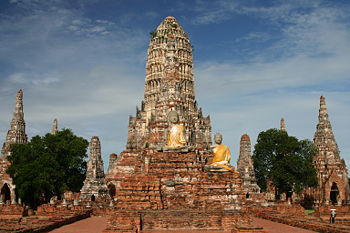Wat Chai Watthanaram
The Wat Chai Watthanaram ( Thai วัด ไชย วัฒนา ราม ) is a Buddhist temple complex ( Wat ) in the Ayutthaya Historical Park , central Thailand .
location
Wat Chai Watthanaram is located on the west bank of the Mae Nam Chao Phraya ( Chao Phraya River ), southwest of the old town of Ayutthaya. This is a great system that the World Heritage Site of UNESCO belongs. It can be reached via the wide road 3263. There is also a nearby boat launch here.
Building history
The temple was built by King Prasat Thong in 1630 as the first temple of his reign on the site of his mother's residence. It shows a central, 35 m high prang in the Khmer style (Thai: พระ ปราง ด์ ประธาน ) with four smaller prangs that stand together on a square platform. About halfway up there are blind entrances on the four sides of the main pavement, to which steep stairs lead up.
The central platform is surrounded by eight chedis (Thai: เมรุ ทิศ เมรุ ราย - Meru Thit Meru Rai ), which are connected by a square cloister ( Phra Rabieng ) . The cloister had several side entrances and was originally roofed and open to the inside, today only the foundations of the columns and the surrounding wall remain. Along the wall there were 120 seated Buddha statues, which were probably decorated with black gold lacquer.
The eight chedi-like chapels are designed in a unique shape, this is what the royal cremation towers ( meru ) of the Ayutthaya period might have looked like. They had paintings on the inner walls, the outer walls were decorated with 12 stucco reliefs with scenes from the life of the Buddha ( Jataka ) , which had to be "read" clockwise. The paintings and the reliefs are only partially preserved. In each of the four corner chedis there were two, in each of the four central chedis there was a large, seated Buddha statue in “royal regalia”, probably also painted with black and gold lacquer. The coffered ceiling above these statues was made of wood and decorated with gold stars on black lacquer.
Outside the cloister was the ordination hall ( Phra Ubosot ) of the temple facing east towards the river . To the north and south of the ubosot stood two chedis with "12 indented corners" (Thai: เจดีย์ อ มุม สิบ สอง ), which probably contain the ashes of King Prasat Thong's mother. The entire ensemble is surrounded by a triple brick wall.
After the total destruction of the Old Capital (Thai: กรุง เก่า - Krung Kao ) by the Burmese in 1767, from which this temple was not spared, Wat Chai Watthanaram was abandoned. Looting, selling bricks from the ruins, and beheading Buddha statues was common practice. It wasn't until 1987 that the Thai Fine Arts Department undertook a restoration. In 1992 the renovated temple was opened to the public.
use
Wat Chai Watthanaram was a royal temple. Many religious ceremonies were carried out here by the king and his descendants, so that several renovations were carried out during the time of the Ayutthaya Kingdom . The cremation of deceased princes and princesses also took place here, for example the corpse of his son Chaofa Thammathibet ( เจา ฟา ธรรม ธิ เบ ศร ) and his first concubine were cremated here by King Boromakot (see also: Thai literature ).
symbolism
The ground plan of Wat Chai Watthanaram reflects the Buddhist worldview as it was written down in the 14th century in the Traiphum Phra Ruang , the "Three Worlds of King Ruang":
The large “Prang Prathan” in the middle symbolizes Mount Meru (Thai: เขา พระสุเมรุ - Khao Phra Sumen ), which represents the central axis of the traditional world ( Kamaphum - กาม ภูมิ ). Around it lie the four continents (the four smaller prangs), which swim in the four cardinal directions in the world ocean ( นที สีทันดร ). The people live on one of the continents called Chomphutawip ( ชมพูทวีป ). Finally, the square cloister is the outer boundary of the world through the "iron mountains " ( กำแพง จักรวาล ).
literature
- Elizabeth Moore et al. a .: Ancient Capitals of Thailand . River Books / Thames And Hudson, Bangkok 1996, ISBN 0-500-97429-2
- Chaiwat Worachetwarawat: Interesting Temples and Ruins in Ayutthaya . Rajabhat Institute Phra Nakhon Si Ayutthaya, Ayutthaya 2001 (without ISBN)
- คู่มือ ท่องเที่ยว เรียน รู้ อยุธยา , Museum Press, Bangkok 2546 (2003), ISBN 974-92888-5-8
- หนังสือ ชุด แผนที่ ความ รู้ เมือง ไทย - วัด และ วัง ใน กรุง เก่า ( Temples and Palaces in the Old Capital City ). Plan Readers Publication, Bangkok 2003, ISBN 974-91126-7-9
- Clarence Aasen: Architecture of Siam: A Cultural History and Interpretation . Oxford University Press , Oxford 1998, ISBN 983-56-0027-9 .
Web links
Coordinates: 14 ° 20 ′ 46 ″ N , 100 ° 32 ′ 30 ″ E




